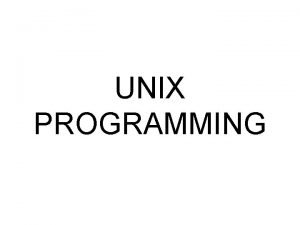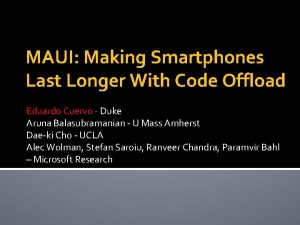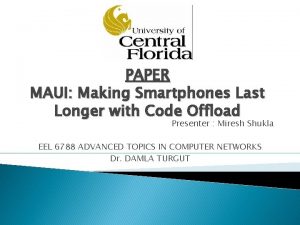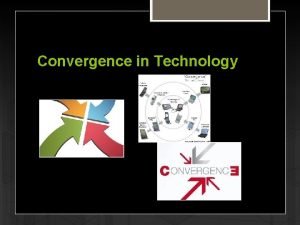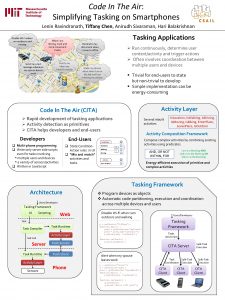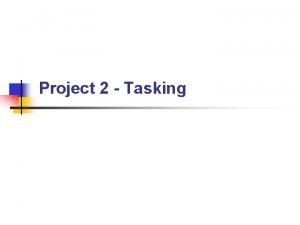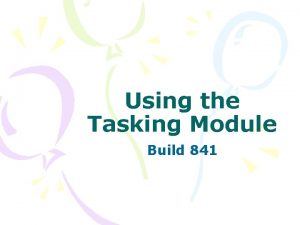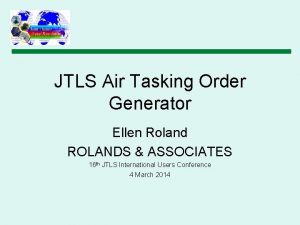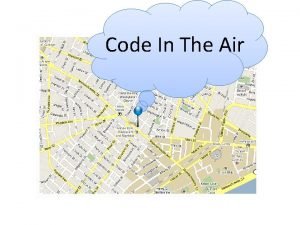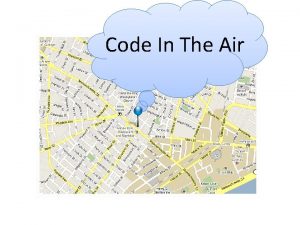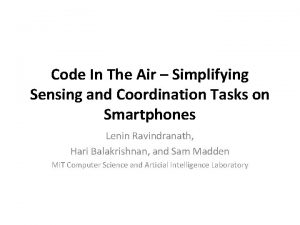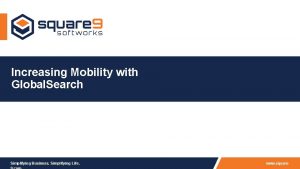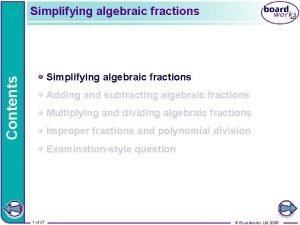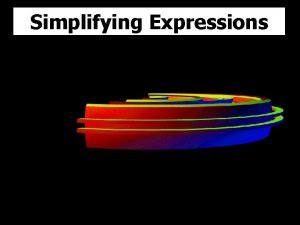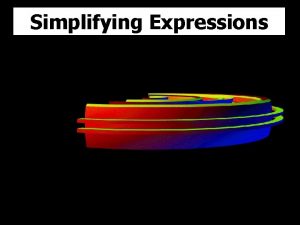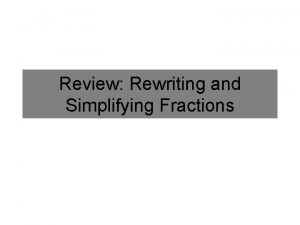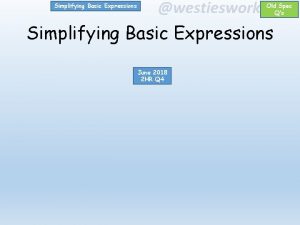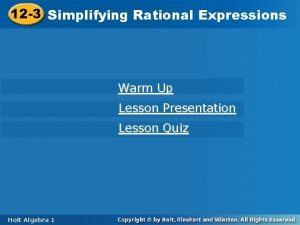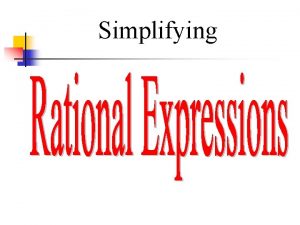Code In The Air Simplifying Tasking on Smartphones































- Slides: 31

Code In The Air: Simplifying Tasking on Smartphones Lenin Ravindranath, Arvind Thiagarajan, Hari Balakrishnan, Sam Madden Massachusetts Institute of Technology

GPS Wi. Fi Cell Accl Gyro Walking Running Sitting Infer Biking Driving Compass Mic Light Proximity Barometer Indoors Outdoors At. Home A growing class of smartphone applications Tasking Applications At. Office

Tasking Applications • Run continuously – In the background – Often require no user input • Infer user context and activity – Process data from multiple sensors • Trigger actions when right conditions are met • Often involve coordination between multiple users or devices

Make my phone silent when I am in the lab and meeting my advisor Alert me when my wife leaves her work Put my laptop to sleep if I am not nearby for 10 minutes Disable Wi-Fi when I am outdoors and walking Turn-on bluetooth when I start driving • Trivial for end-users to state – As condition-action rules • Non-trivial or extremely difficult to develop

Today they are difficult to develop… • Poor abstractions – Requires grappling with low level sensor data – For example: “is walking” – process accelerometer data – An ideal solution: is. Walking primitive • Poor programming support – Tasking applications are often inherently distributed – Involves writing server-side and smartphone code – A better approach: Macroprogramming approach • No end-user support – End-users have no interest or ability to write code – Solution: A easy way to combine existing capabilities to create tasks Simplementations can be energy consuming

Code In The Air (CITA) A system that significantly lowers the barrier for programming and executing tasking applications Developers • Activity detection as primitives – For example: Is. Walking, Is. Biking, etc. • Programming model – Write centralized code even for tasks involving multiple devices – Automatic partitioning and coordination • Significantly reduces coding and deployment effort End-Users • UI to program condition-action rules • “Mix and match” existing activities and tasks to create new tasks

Users Developers Tasks CITA Architecture Activity Layer • Raises the abstraction - UI “activities” Tasking Framework – is. Driving – is. Biking – is. Nearby Tasks Task Compiler Sub task • Sub task Task runtime CITA Server Activity Layer Sub task Tasking Framework • Developer writes task – Java. Script • Task runtime Activity Layer Sensors CITA Client UI Accurate and energyefficient recognition Compile into sub-tasks – Server-side code – Mobile code • • Manages task execution run-time and coordination UI for end-users

Activity Layer • Raises the abstraction from “raw sensor data hacking” to activities and “activity composition” • Several inbuilt user activity detectors enter. Place leave. Place is. Walking is. Biking is. Outdoors is. Indoors in. Place is. Nearby is. Driving is. Moving is. Static Extensible activity layer: Build and deploy new activity detectors

Place Hierarchies Energy-efficient detection of activities

Activity Composition • Compose lower-level activities using logical predicates to create higher-level activities – Reuse activities created by others to create complex activities is. Outdoors AND is. Walking is. Biking OR is. Driving Disable Wi-Fi when user is outdoors and walking NOT is. Outdoors leave(Work) AND is. Driving WITHIN 5 min NOT is. Nearby(p, l) FOR 1 min is. Place(Home) NEXT is. Place(Work) Put my laptop to sleep if I am not nearby for 10 minutes

Activity Composition Lenin. Meeting NOT in (Office) AND in (Stata. Building) nearby (Lenin) AND NOT Lenin. Meeting AND nearby (Hari) FOR 2 min Alert me to “pay him for the movie” OR nearby (Sam) FOR 2 min Energy-efficient detection of composed activities

Users Developers CITA Architecture Activity Layer • Raises the abstraction - Scripts UI “activities” Tasking Framework – is. Driving – is. Biking – is. Nearby Tasks Task Compiler Sub task • Sub task Task runtime CITA Server Activity Layer Sub task Tasking Framework • Developer writes task – Java. Script • Task runtime Activity Layer Sensors CITA Client UI Accurate and energyefficient recognition Compile into sub-tasks – Server-side code – Mobile code • • Manages task execution run-time and coordination UI for end-users

Tasking Framework Developers ecosystem Programming Model End-Users User Interface • Developers write scripts to build tasking applications • Activities and tasks are added to the UI for end users to use • UI allows users to specify “condition-action” tasks • Activities and tasks are reused to build complex tasks

Code In The Air UI

Programming Model • Tasks are written as Java. Script programs • Devices are exposed as objects – A developer can simply call methods on the object to manipulate it p = get. Device(‘Lenin’, ‘Android’) p. ringer. set. Mode(SILENT); – Work with multiple phones in a single script q = get. Device(‘Arvind’, ‘Default’) r = q. ringer. get. Mode(); p. ringer. set. Mode(r); • CITA automatically partitions the task into sub-tasks, executes and coordinates them across devices

Example: Single-Device Task Disable Wi-Fi when outdoors and moving p = get. Device(param_user, param_phone); p. register. Callback(“outdoor_walking", "true. Action", "false. Action"); function true. Action(e) { old. State = p. wifi. get. State(); store. add(“old. State”, old. State); p. wifi. disable(); } true outdoor AND walking false function false. Action(e) { p. wifi. set. State(store. remove(“old. State”)); }

Example: Multi-Device Task Alert me when Hari comes to his office p = get. Device(“hari”, default); q = get. Device(“lenin”, default); p. register. Callback(“enter(hari. office)", "true. Action"); function true. Action() { q. alert(“Hari is here"); } CITA Server lenin hari Call: lenin. phone. true. Action this. register. Activity. Callback(“ enter(office)", “lenin. phone: true. Action"); function true. Action() { this. alert(“Hari is here"); }

Example: Cloud-Enabled Task Store GPS tracks in server when biking p = get. Device(param_user, param_phone); p. register. Activity. Callback(" biking", "true. Action", "false. Action"); function true. Action(e) { params = new Object(); params. sample. Period = 1; params. tag = get. Unique. Id(); p. register. Data. Callback("gps. data", "data. Action", params); } function false. Action(e) { p. unregister. Callback("gps. data", "data. Action"); } function data. Action(e) { Server. store. add("biking. Tracks", e. tag, e. data. time, e. data. lat, e. data. lng); }

Code Partitioning • Function level partitioning F 1 { p. foo() } F 2 { p. foo() q. foo() } p. register. Callback() F 3 { a = b + c; } • Even a random partitioning – Does not affect the correctness of the execution – Calls and callbacks are delegated appropriately

Challenges • Push Mechanism – Dial-to-Deliver • Handle disconnections – Calls and callbacks can be delayed or dropped – Developer can set policies • Privacy – User policies • Energy – Enforce energy budget – User policies

Related Work • Tasking applications – Locale, Tasker, Touch. Develop • Programming frameworks – App. Inventor – Visual programming interface – Phone. Gap, Appcelerator – HTML/Java. Script framework – App. Makr – Web based feeds – PRISM – Sensing applications – m. Crowd – Crowd sourcing applications – See. Mon – Composition framework for activities

Code In The Air • A system that significantly lowers the barrier for programming and executing tasking applications – Developers: Java. Script based – End Users: UI based • Status – Energy-efficient activity detectors – Android client – i. Phone client – Windows laptop client – Plan to release by this Fall

CITA If I am leaving home and the weather forecast is rainy, alert me to take an umbrella

Backup

Place Hierarchies SSID • • Named Location Hierarchy - Room level - Floor level - Building level - Box (Map)

Energy Efficient Detection in (Seattle) In (Hari. Office) Lenin’s Office Hari’s Office Which sensor to use? How often to sample? Measure of distance? Sample only when moved Rate of movement

Activity Detection • Divide and run individual activity detectors in the respective devices – If activity spans multiple devices, coordinate at the server. • Energy efficient execution – Cost modeling predicates – Low energy cost execution plan is. Outdoors AND is. Walking

Handling Disconnections • When devices are disconnected – Calls and callbacks cannot be delivered in real-time Alert GPS Bob Delayed Alice Dropped after some time • Developers can set policies on how to deal with disconnections – Task-wide policies – Callback specific policies

Energy-Efficient Detection APs GPS Accl Gyro Cell towers Predict Speed • From rate of change - Access Points - Cell Towers

Today they are difficult to develop… • Poor abstractions – Requires grappling with low level sensor data – For example: “is walking” – process accelerometer data – An ideal solution: is. Walking primitive • Poor programming support – Tasking applications are often inherently distributed – Involves writing server-side and smartphone code – A better approach: Macroprogramming approach • No end-user support – End-users have no interest or ability to write code – Solution: A easy way to combine existing capabilities to create tasks

Today they are difficult to develop… • Poor abstractions – Requires grappling with low level sensor data – For example: “is walking” – process accelerometer data • Poor programming support – Tasking applications are often inherently distributed – Involves writing server-side and smartphone code • No end-user support – End-users have no interest or ability to write code – No way to put together an application
 History of unix
History of unix Next gen md
Next gen md Maui: making smartphones last longer with code offload
Maui: making smartphones last longer with code offload Maui: making smartphones last longer with code offload
Maui: making smartphones last longer with code offload Muitos smartphones e tablets não precisam mais de teclas
Muitos smartphones e tablets não precisam mais de teclas Evolução dos smartphones
Evolução dos smartphones Convergence of technology examples
Convergence of technology examples Air higroskopis air kapiler dan air gravitasi
Air higroskopis air kapiler dan air gravitasi Busceral
Busceral Hát kết hợp bộ gõ cơ thể
Hát kết hợp bộ gõ cơ thể Frameset trong html5
Frameset trong html5 Bổ thể
Bổ thể Tỉ lệ cơ thể trẻ em
Tỉ lệ cơ thể trẻ em Chó sói
Chó sói Chụp phim tư thế worms-breton
Chụp phim tư thế worms-breton Chúa sống lại
Chúa sống lại Các môn thể thao bắt đầu bằng từ đua
Các môn thể thao bắt đầu bằng từ đua Thế nào là hệ số cao nhất
Thế nào là hệ số cao nhất Các châu lục và đại dương trên thế giới
Các châu lục và đại dương trên thế giới Công của trọng lực
Công của trọng lực Trời xanh đây là của chúng ta thể thơ
Trời xanh đây là của chúng ta thể thơ Mật thư tọa độ 5x5
Mật thư tọa độ 5x5 Làm thế nào để 102-1=99
Làm thế nào để 102-1=99 độ dài liên kết
độ dài liên kết Các châu lục và đại dương trên thế giới
Các châu lục và đại dương trên thế giới Thơ thất ngôn tứ tuyệt đường luật
Thơ thất ngôn tứ tuyệt đường luật Quá trình desamine hóa có thể tạo ra
Quá trình desamine hóa có thể tạo ra Một số thể thơ truyền thống
Một số thể thơ truyền thống Cái miệng nó xinh thế
Cái miệng nó xinh thế Vẽ hình chiếu vuông góc của vật thể sau
Vẽ hình chiếu vuông góc của vật thể sau Nguyên nhân của sự mỏi cơ sinh 8
Nguyên nhân của sự mỏi cơ sinh 8 đặc điểm cơ thể của người tối cổ
đặc điểm cơ thể của người tối cổ
